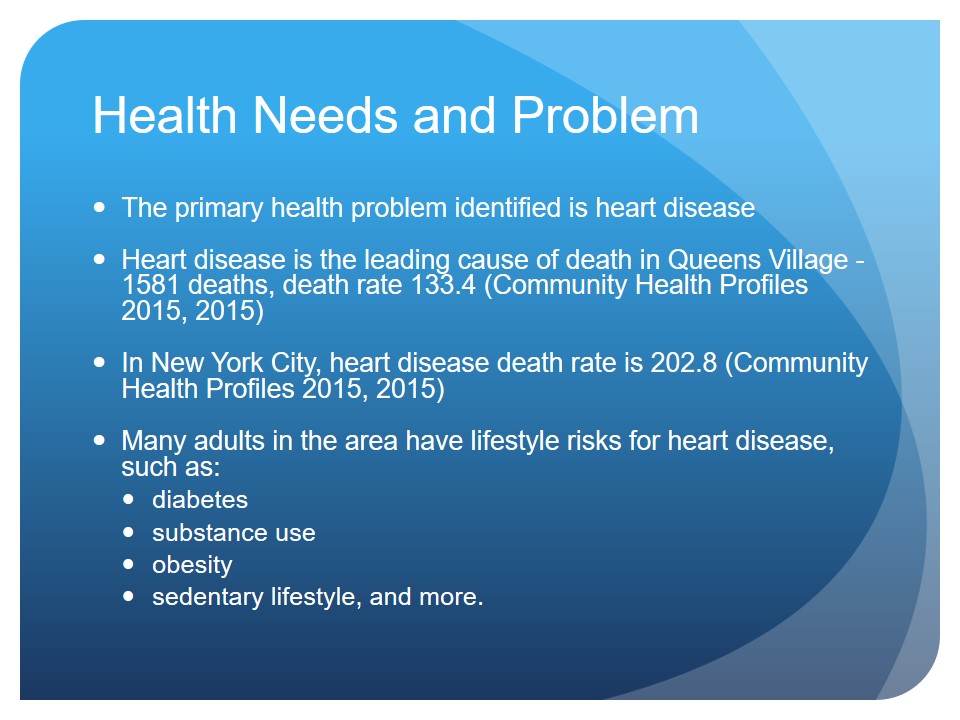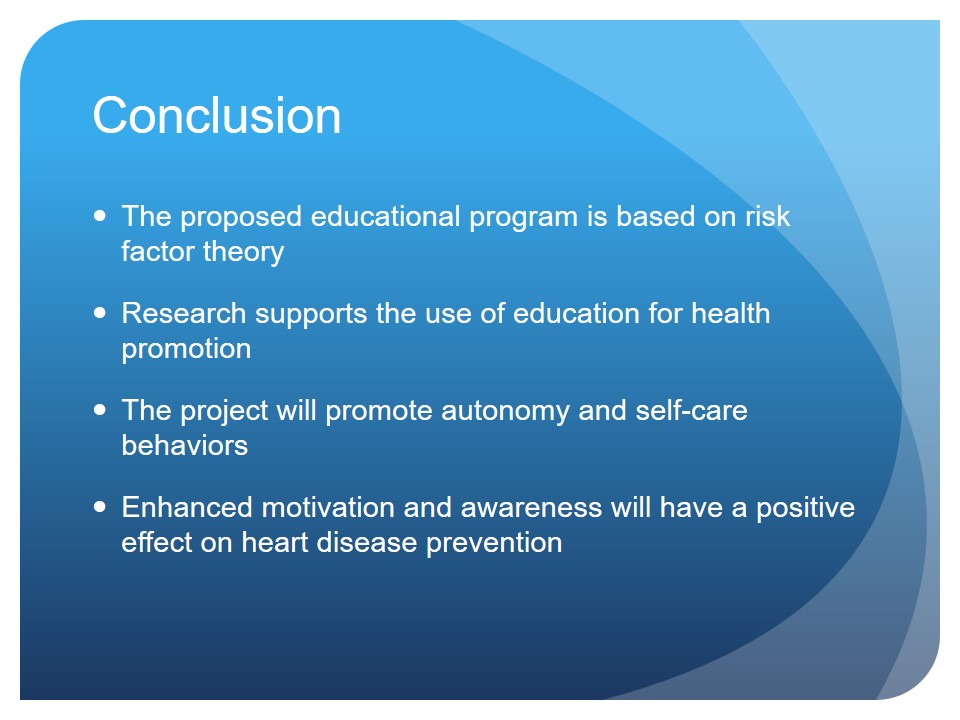Introduction
- Community health promotion is critical to improving population health.
- Nurses can help to improve access to services and health literacy.
- Developing an intervention requires assessing the population and its needs.
- Relevant theories can be used to design the intervention and target a population group.
- The presentation will describe the community, health needs, and the educational proposal.
Community health promotion plays a crucial role in improving population help. In particular, community-based interventions led by nurses are effective, as nurses have knowledge and skills to improve access to services and health literacy of the chosen population. Developing a practical community-based intervention requires assessing the population and its needs. Relevant theories can be used to design the intervention and ensure that it targets a specific population group. This presentation will describe the chosen community, its health needs, and the educational proposal.

Community
- The chosen community is Queens Village.
- Racially diverse: African American – 60.9%, Asian – 13.09%, Caucasian – 8.78%, Hispanic-12% (“Queens Village,” 2018).
- Good infrastructure, including schools, hospitals, libraries, banks, and other resources (Community District Profiles, 2015).
- Different age groups present: children 0-17 (18%), young adults 18-24 (10%), adults 25-54 (43%), older adults (28%) (Niche, 2018).
The chosen community is Queens Village, NY. The population of Queens Village is racially diverse, with 60.9% African Americans, 13.09% Asians, 8.78% Caucasians, and 12% Hispanics. Queens Village has a well-developed infrastructure, with enough schools, hospitals, libraries, banks, shops, clinics, and other important resources. The population is also diverse in terms of age. 18% of residents are children aged 0 to 17, 10% are young adults aged 18-24, 43% are adults aged 25-54, and 28% are older adults. The diversity of the chosen population provides opportunities for various targeted health promotion efforts.

Target Population and Community
- The target population is adults 35-55.
- Have risk factors for heart disease, such as (Department of Health and Human Services, 2017):
- alcohol or drug use;
- smoking;
- diabetes and prediabetes;
- high body weight or obesity;
- unhealthy diet;
- having a family history of heart disease;
- sedentary lifestyle;
- Target group can be located in local churches.
As the main health problem identified as part of the survey is heart disease, the target population are adults aged 35-55 years who have risk factors for heart disease. The risk factors include substance use, smoking, diabetes and prediabetes, obesity, unhealthy lifestyle, and family history of heart disease. The target group can be located and recruited in local churches, as the population of Queens Village has an abundance of religious resources.

Health Needs and Problem
- The primary health problem identified is heart disease.
- Heart disease is the leading cause of death in Queens Village – 1581 deaths, death rate 133.4 (Community Health Profiles 2015, 2015).
- In New York City, heart disease death rate is 202.8 (Community Health Profiles 2015, 2015).
- Many adults in the area have lifestyle risks for heart disease, such as:
- diabetes;
- substance use;
- obesity;
- sedentary lifestyle, and more.
According to Community Health Profiles 2015 (2015), the most critical health problem in the area is heart disease. It is the leading cause of death in Queens Village, with 1581 deaths and a death rate of 133.4. Although the death rate for heart disease is higher in New York City (202.8), it is still important to address this health problem, as many adults in the area have lifestyle risks for heart disease. During the windshield survey, it was identified that many adults have obesity and lead a sedentary lifestyle, while population health statistics confirm that they also suffer from diabetes and substance use disorders.

Goals
- Healthy People 2020 goal is to “improve cardiovascular health and quality of life through prevention, detection, and treatment of risk factors for heart attack and stroke” (ODPHP, 2014, para. 1).
- Healthy People 2020 objective is HDS-1, “Increase overall cardiovascular health in the U.S. population” (ODPHP, 2014, para. 14).
- Measurable goal: to improve people’s knowledge of cardiovascular disease prevention.
- Results: over 70% of participants agree on improved awareness of heart disease prevention.
As stated by the Office of Disease Prevention and Health Promotion (ODPHP, 2014), one of the crucial Healthy People 2020 goals is to “improve cardiovascular health and quality of life through prevention, detection, and treatment of risk factors for heart attack and stroke” (para. 1). The related Healthy People 2020 objective is HDS-1, which is to “increase overall cardiovascular health in the U.S. population” (para. 14). A measurable goal of the project is to improve people’s knowledge of cardiovascular disease prevention. Upon completion of the program, over 70% of participants should agree that their awareness of cardiovascular disease prevention strategies has improved.

Educational Topic
- Education will address cardiovascular disease prevention in adults.
- Research supports that education can be used to improve awareness of risk factors (Altman, Nunez de Ybarra, & Villablanca, 2014).
- Increased awareness can motivate people to engage in self-care (Feigin, Norrving, & Mensah, 2017).
- Self-care behaviors help to prevent cardiovascular disease (Riegel et al., 2017).
- Risk factor theory forms the basis of this program (Edelman & Kudzma, 2018).
- The majority of Queens Village adults have a medium level of education: high school degree – 32%, college degree – 31%, bachelor’s degree – 15% (Niche, 2018).
- Good level of education would allow them to apprehend basic health information and make informed health decisions.
The proposed education project will address cardiovascular disease prevention in adults using lifestyle modifications. The project is largely based on the risk factor theory (Edelman & Kudzma, 2018). The effectiveness of this project is supported by research. First of all, research supports that education can be used to improve awareness of risk factors (Altman, Nunez de Ybarra, & Villablanca, 2014). Secondly, increased awareness can motivate people to engage in self-care (Feigin, Norrving, & Mensah, 2017). Thirdly, appropriate self-care behaviors, such as diet and exercise, help to prevent cardiovascular disease (Riegel et al., 2017). Thus, the project will help to prevent heart disease by educating participants on lifestyle health promotion. The majority of Queens Village adults have a medium level of education. For instance, 32% of people have a high school degree, and 31% have a college degree (Niche, 2018). Thus, a good level of education shows that they will be able to apprehend basic health information and make informed health decisions.

Educational Proposal – Teaching Content
- Teaching content will focus on risk factors for heart disease and lifestyle prevention.
- Promoting physical activity and a healthy diet.
- Encouraging people to avoid substance use and smoking.
- Providing information about health services.
The teaching content will focus on risk factors and prevention methods. It will promote physical activity and healthy eating, encourage people to avoid substance use and cease smoking, and provide information about health services available in the community to improve access to care.

Educational Proposal – Teaching Methods
- Teaching methods are determined based on (Eldredge, Markham, Ruiter, Kok, & Parcel, 2016):
- group size;
- facility;
- length of intervention;
- goals of education.
- Teaching methods used should give meaningful information.
- Presentations are often used to encourage lifestyle modifications (Sink et al., 2015).
- Chosen methods are weekly interactive presentations carried out in 60 to 90-minute classes.
According to Eldredge, Markham, Ruiter, Kok, and Parcel (2016), teaching methods depend on the group size, the facility, the length of an intervention, and the goals of education. To fulfill the goals of this project, teaching methods should provide meaningful information. For instance, presentations are often used to encourage lifestyle modifications (Sink et al., 2015). Thus the chosen methods are weekly interactive presentations carried out in 60 to 90-minute classes.

Educational Proposal – Expected Outcomes
- Knowledge of risk factors for heart disease.
- Motivation to improve lifestyle.
- Awareness of community resources.
- Inspiration to promote lifestyle change.
As a result of the project, participants will be able to name and explain risk factors for heart disease. They will also be able to assess their risk of heart disease. Participants will also obtain information about community resources available to them. Finally, they will be motivated to improve their lifestyle and promote lifestyle change in their families, workplaces, and other groups.

Educational Proposal – Evaluation Method
- Evaluation methods depend on the goal of the intervention (Eldredge et al., 2016).
- The goal is to improve people’s knowledge.
- Surveys are quick and can be expanded to provide more meaningful information.
- Surveys with statements rated on Likert Scale should be used to evaluate the intervention.
The choice of a particular evaluation method depends on the intervention. As the goal is to improve people’s knowledge, surveys can be used for self-evaluation. Surveys will contain statements that can be rated on a Likert scale.

Conclusion
- The proposed educational program is based on risk factor theory.
- Research supports the use of education for health promotion.
- The project will promote autonomy and self-care behaviors.
- Enhanced motivation and awareness will have a positive effect on heart disease prevention.
Overall, the proposed educational program is based on risk factor theory and is supported by research. The project will promote autonomy and self-care behaviors, while also providing enhanced motivation and awareness. It is likely that education will have a positive long-term effect on heart disease prevention in the area.

References
- Altman, R., Nunez de Ybarra, J., & Villablanca, A. C. (2014). Community-based cardiovascular disease prevention to reduce cardiometabolic risk in Latina women: A pilot program. Journal of Women’s Health, 23(4), 350-357.
- Community District Profiles. (2015). Queens community district 13. Web.
- Community Health Profiles 2015. (2015). Queens community district 13: Queens Village. Web.
- Department of Health and Human Services (DHHS). (2017). What are the risk factors for heart disease? Web.
- Edelman, C. L., Kudzma, E. C. (2018). Health promotion throughout the lifespan (9th ed.). St. Louis, MO: Elsevier.
- Eldredge, L. K. B., Markham, C. M., Ruiter, R. A., Kok, G., & Parcel, G. S. (2016). Planning health promotion programs: An intervention mapping approach (4th ed.). John Wiley & Sons.
- Feigin, V. L., Norrving, B., & Mensah, G. A. (2017). Primary prevention of cardiovascular disease through population-wide motivational strategies: Insights from using smartphones in stroke prevention. BMJ Global Health, 2(2), e000306.
- Niche. (2018). Queens Village. Web.
- Office of Disease Prevention and Health Promotion (ODPHP). (2014). Heart disease and stroke. Web.
- Queens Village, New York, NY demographics. (2018). Web.
- Riegel, B., Moser, D. K., Buck, H. G., Dickson, V. V., Dunbar, S. B., Lee, C. S., … Webber, D. E. (2017). Self‐care for the prevention and management of cardiovascular disease and stroke: A scientific statement for healthcare professionals from the American Heart Association. Journal of the American Heart Association, 6(9), e006997.
- Sink, K. M., Espeland, M. A., Castro, C. M., Church, T., Cohen, R., Dodson, J. A., … Williamson, J. D. (2015). Effect of a 24-month physical activity intervention vs health education on cognitive outcomes in sedentary older adults: The LIFE randomized trial. Journal of the American Medical Association, 314(8), 781-790.